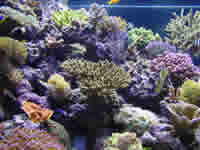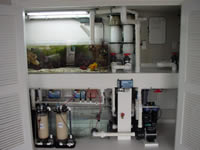
|
|
||||||||||||||||||||||||||||||||||||||||||||||||||||||||||||||||||||||||||||||||||||||||||||||||||||||||||||||||
Steve Weast's Reef Tank |
|||||||||||||||||||||||||||||||||||||||||||||||||||||||||||||||||||||||||||||||||||||||||||||||||||||||||||||||
 |
 |
 |
The Tank
The tank size was limited in two areas. First, the tank had to look in scale with the wall that it was to be “hung” on. Second, the depth of the tank was limited by the available space on the garage side of the wall. These factors determined that the tank would have a capacity of 500 gallons, have a dimension of 72"L X 30"H X 48"D and be constructed from 1 inch thick acrylic. The tank has two 10 inch square black acrylic overflows in the rear of each corner. The clear acrylic back and sides of the tank have ¼ inch removable black acrylic panels on the outside which, when removed, permit inspection behind and under the rockwork.
 |
 |
 |
The Stand
Since the tank and all its components are located in the garage and since the garage floor is 4 feet below the house floor level, the tank would be sitting on a stand that is eight feet high with a total weight of around 5000 pounds. An eight foot height meant that the equipment compartment was really a small room. The stand was constructed as a house would be built, with framed walls, floor joists, sheetrock, trim, and paint. One of the goals of the system design was to have a clean, clutter free look on both sides of the wall. A small mechanical room made this requirement easy.
 |
 |
 |
|
Aquarium Profile
|
 |
 |
 |
The Plumbing and Filtration
The Berlin method is utilized for the display, with live rock and protein skimming being the main filtration. Since most of the biological filtration takes place in the display tank, only enough water to run the skimmers, reactors, probes, and refugium is needed to pass through the water overflows. An Ampmaster 3000, with around 2600GPH after head pressure reductions, is utilized. The plumbing has two main “legs”. The first leg has water coming from one of the 10 inch square overflows (after passing through a 2 inch perforated pipe wrapped in a prefilter pad) and continuing to two 1000 watt Aquadyne Fireplug heaters and terminating in the sump baffle. The second leg flows from the other overflow and continues through a ¾ hp Aqua Logic chiller and again terminates in the sump baffle. Because the tank is eight feet above the sump, no pump is needed to run water directly through the heater or chiller units. Water is just pumped from the sump back into the display tank. Gravity provides more flow through the heater and chiller units than is required; therefore, the water backs up in the pipe back towards the overflow. Before the water can reach the overflow, water is bled off into the 125 gallon refugium. The refugium then gravity feeds into the sump. The plumbing is sized as to allow all the water to flow directly through the refugium without water backing up to the overflow, if desired. This allows (through shut-off valves) maintenance to occur on either the heater or chiller plumbing legs without shutting off the main pump. From the sump, there are two more Ampmaster 3000 pumps that run the four Precision Marine Bullet 3 protein skimmers (one pump for two skimmers or about 1500GPH for each skimmer). The skimmer water also terminates in the sump baffle. The sump, which is also 125 gallons, has a 22 X 8 inch sump baffle. This baffle prevents bubbles from entering the display tank as well as providing a place to place carbon and phosphate removing media. That’s it for filtration; however, to meet the low maintenance requirement, a few more things have been added. First, all skimmer collection cups are connected directly to the house’s sewer system. Secondly, all evaporation is automatically added by an RO-DI unit with a float switch in the sump. And lastly, two Precision Marine calcium reactors keep up with the calcium and buffer requirements with an Aquadyne Octopus 3000 controlling the lights and temperature while monitoring the pH, redox, and conductivity. The 125 gallon refugium grows Caulerpa with 200 watts of light for nutrient export.
 |
 |
 |
|
Lighting Profile
|
 |
 |
 |
The Lighting
The lighting proved to be the most difficult design component to meet the low maintenance, easy access requirement. The light hood is constructed of wood and covered in Formica. It is mounted on a rail system above the tank. On top of the hood is all the ballasts and wiring. The main power comes from the ceiling to a main junction box on the hood. This design allows the hood to be slid from one side or the other with ease without interference from power wires or hot bulbs. The hood contains (8) 400 watt metal halide 10,000K bulbs and (6) 165 watt VHO actinic bulbs. Cooling is provided by (10) 4 inch computer fans.

|  |
 |
|
Maintenance
|
 |
 |
 |
|
The Chemistry
|
 |
 |
 |
The Rockwork and Circulation
There are 1200 pounds of Fiji and Marshall Island live rock in the display tank. The rock is elevated 4 inches off the tank bottom to facilitate detritus removal by the powerheads. The sand bed is 2-4 inches of aragonite sand with the exception of the front panel where the depth is zero to facilitate the cleaning of the front panel. Circulation is accomplished by 12 Tunze 3000 powerheads that pump 792GPH each. There are four powerhead towers made from PVC that hold three powerheads each. The outflows are plumbed to various locations in the rockwork (usually terminating from a hole in the rocks). Five of the powerheads are dedicated to moving water under and behind the rockwork while the remaining seven move water in the open tank. Each powerhead tower is located on each side of both overflows just behind the rocks. If necessary, the plumbing is disconnected through unions and the whole tower can be removed for servicing.
 |
|
Powerhead Tower
|

|  |
 |
The Current Condition and Lessons Learned
This is a young tank…just one year old; and, as a young tank, it still has that “placed” look to it. But given time, the corals will continue to grow to create a more natural look. The existing corals came to me as frags, small colonies, and some large colonies. Several early frags are now large colonies; most notably, the Alveopora and the Millepora. For several months, I kept a few carnation corals; however, after time, they showed little if any growth. I decided to donate them to another aquarist’s system that was dedicated to these corals rather than try to raise my nutrient levels to accommodate them. I do continue to keep several Scleronephthya and Neospongodes corals that have shown some growth. Initially, I was keeping several soft corals, most notably, various leather corals and Sinularia spp. These corals rapidly began to dominate the tank with their accelerated growth thus forcing their removal. The system has evolved over the past year to a display dominated by mostly hard corals with a few soft corals for diversity. I believe the current mix will one day turn into a remarkable, natural looking display.
Feel free to ask questions or post comments about my tank in the discussion forum.
 |
 |
 |
Livestock:
|
Hard
Corals
|
|
Red Stylophora
|
Alveopora
|
|
Red Pocillopora
|
Gonipora
|
|
Red Seriatopora
|
Euphyllia
|
|
Various Acropora
|
Catalaphyllia
|
|
Various Millepora
|
Cynaria
|
|
Montipora digitata
|
Tubinaria
|
|
Montipora confusa
|
Blastomussa
|
|
Montipora capricornis
|
|
|
Anemones
|
|
Common name
|
Scientific name
|
|
Rose anemone
|
Entacmaea quadricolor
|
|
Blue carpet
|
Stichodactylla haddoni
|
|
Soft
Corals
|
|
Common name
|
Scientific name
|
|
Green star polyp
|
P. violacea
|
|
Yellow leather
|
Sarcophyton elegans
|
|
Purple gorgonian
|
Muriceopsis flavida
|
|
Red Sea Xenia
|
|
|
Various Neospongodes
|
|
|
Various Scleronephthya
|
|
|
Various corallimopharians
|
|
|
Fish
|
|
Common name
|
Scientific name
|
|
Scribbled boxfish
|
Ostracion solorensis
|
|
Copperbanded butterfly
|
Chelmon rostratus
|
|
Four stripe damsel
|
Dascyllus melanurus
|
|
Gold stripe maroon clown
|
Premnas biaculeatus
|
|
Saddleback clown
|
Amphidron polymnus
|
|
Flame hawkfish
|
Neocirrhitus armatus
|
|
Longnose hawkfish
|
Oxcirrhitus typus
|
|
Red tail wrasse
|
Anampees chrysocephalus
|
|
Leopard wrasse
|
Macropharygondon meleagris
|
|
Purple Red Sea tang
|
Zebrasoma xanthurus
|
|
Red Sea sailfin tang
|
Zebrasoma desjardinii
|
|
Diamond goby
|
Valenciennea puellaris
|
|
Lyretail anthias
|
Pseudanthias squamidinnis
|



